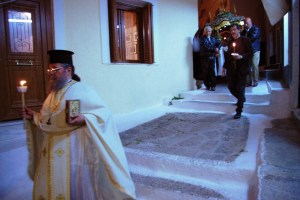
Poros’s tavernas today are arrayed along the waterfront, from the marina down to the old harbor district of Pounta. This was not always the case.
In the 1950s and 1960s, they were clustered inside the town along the ‘Yahni sokaki’, literally ragout passage, which runs parallel to the main road and links the town center’s two squares, Iroon and Dimarheiou. Few of these tavernas had the names like those you see today, but instead were known simply by their owners’ surnames—or nicknames.
Strolling down this narrow lane, one’s senses were assaulted by the sights and smells of delicious meze being prepared in blackened skillets over high flames. Fried smelt, chicken livers, cod, or cheap cuts of meat from the butchers in the nearby agora all went into the pan with generous amount of locally-produced olive oil. Other meze staples were herring, lakerda (pickled mackerel), sardines, olives, feta. Tavernas were not just for dinner; indeed, many did most of their business at lunchtime, catering to fishermen, boatmen, resin pickers, farmers, and traveling sales reps. There were also some quaint customs linked to the taverna: it was believed to be bad luck for a father and son to drink wine together at the same taverna, so if a son saw his father inside, he would go elsewhere.
Though delicious, the food was merely the accompaniment to the wine served from barrels or flasks and by which the taverna was ultimately judged. “Drink wine: the water isn’t clean,” a sign on one taverna wall advised—and it was advice which most locals took seriously. Indeed, the alcohol was used as an antibacterial agent and added to water (in a ratio of one to nine) as a precaution against dysentery and other diseases.
As local historian and author Yannis Poulakis notes, wine meant retsina, the pale honey-colored wine with the distinctive flavor of pine resin. As anyone who has tried retsina knows, it’s an acquired taste—and one that is enjoying renewed popularity today as modern winemakers adapt old wine-making techniques to contemporary palates.
Adding resin to wine was an old custom—and not just on Poros. Pine resin was used as a natural preservative and enhances the wine’s digestive properties, but as Poulakis notes, on Poros it served an additional purpose: protecting against malaria. Mosquitoes swarmed the area, especially Trizina on the Peloponnese coast with its marshy terrain. Filling someone’s wine glass above half was considered disrespectful. It was also an insult not to raise one’s glass and clink it with others’ glasses while wishing stin hygeia mas (to our health) to those at the table.
Greeks revere wine, which in mythology was associated with the god Dionysus and later with his Christian namesake, Saint Dionysios. To this day, it is customary for winemakers to open new wines on his feast day, December 17. But on Poros, it’s another saint who is associated with wine—Ayios Georgios. This is because in local lore, a spring near the church dedicated to the saint was once found to flow with wine rather than water.
Pounta, the old fisherman’s quarter at the town’s southern end, was also known for its tavernas. The Nosis winery was also located there in the 1950s and old-timers fondly recall the seafront crammed with a long row of wooden barrels every summer to be cleaned for the new wines. Most of the local wines were from vineyards at Foussa, the small plateau atop Kalavria.
While few of the town’s old tavernas have survived, many of the restaurants outside the town itself have. Among them Aspros Gatos and Matina’s at Perlia and Mourtzoukos’s at Neorio.













